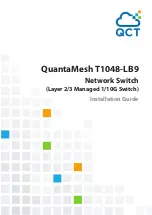
1-9
master, and execute some simple commands on the slaves, like
display
,
terminal
,
debug
, and so on,
as shown in the following table.
Complete the following tasks to configure IRF:
Task
Remarks
Switching Operating Mode
Optional
Setting a Member ID for a Device
Required
Specifying a Priority for an IRF Member
Optional
Configuring IRF Ports
Optional
Specifying the Preservation Time of IRF Bridge
MAC Address
Optional
Configuring IRF
Setting the Delay Time for the Link Layer to
Report a Link-Down Event
Optional
Connect the physical IRF ports of devices by using IRF cables, and then power on the devices.
Enabling BFD MAD detection
Optional
Enabling LACP MAD detection
Optional
Specifying the reserved ports
Optional
Configuring MAD
Detection
Failure recovery
Optional
Accessing the Master
Required
Accessing an IRF
Accessing a Slave
Optional
After establishing an IRF, you are recommended to enable the MAD detection function to avoid the
influences to the network caused by accidental IRF split.
Switching Operating Mode
The device supports two operating modes:
z
IRF mode: When a device works in this mode, it interconnects with other devices to form an IRF.
z
Standalone mode: The device operates in a standalone manner. It does not form any IRF with
other devices. In this mode, the IRF function is disabled on the device, so the device does not
execute any IRF-related command.
After an EPON card is installed in an S7900E switch, the switch can work as an OLT device in an EPON
system. Note that:
Summary of Contents for S7906E - Switch
Page 82: ...1 4 DeviceA interface tunnel 1 DeviceA Tunnel1 service loopback group 1...
Page 200: ...1 11 DeviceB display vlan dynamic No dynamic vlans exist...
Page 598: ...ii...
Page 1757: ...4 9...
Page 1770: ...6 4...
Page 2017: ...2 11 Figure 2 3 SFTP client interface...
Page 2238: ...1 16 DeviceA cfd linktrace service instance 1 mep 1001 target mep 4002...
















































